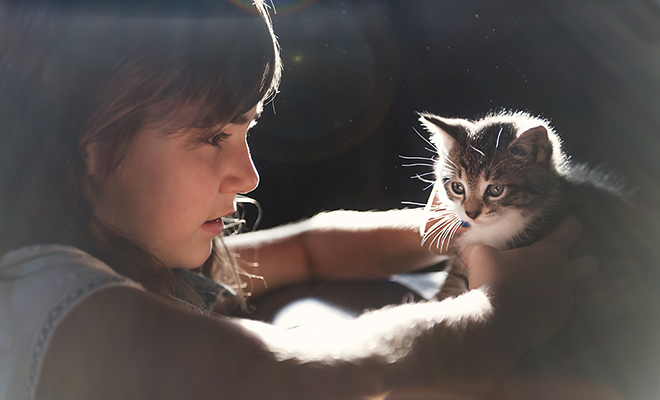
There’s a New Pet in the House!
Bringing home a new puppy, kitten or a grown dog or cat takes more effort than many people imagine. But there are ways to make the transition easier for both the new pet and the family. The secret? Preparation.
Before a new pet comes into your home, visit a good pet supply store. You’ll need to have a lot of things ready to go to make your new companion’s first days less stressful and easier for you, too.
It’s a Dog’s Life
Have the water and food bowls, training treats, a half-dozen dog toys, a soft adjustable collar or harness, a leash thats four to six feet long, and a doggie bed ready. Choose the same kind of food that your new dog is accustomed to eating. For some dogs, an abrupt change in food can cause digestive distress. You can gradually switch, if you wish, later. Make sure there are plenty of puppy pads ready until the puppy is housetrained.
“It’s like bringing a new child home. Don’t leave things around they can get into, especially small things that they can swallow,” said veterinarian Dr. Genya Metzen, with Best Friend’s Animal Hospital in Bloomington, Minnesota. Puppies will chew anything they can get their teeth on; they don’t know the difference between their toys and your remote control.
Many dog owners recommend crates to use when the family is sleeping or at work. Crates should be big enough to hold a training pad, food, water and toys, and be big enough for the dog to turn around. Others recommend using a dog playpen. These come in a number of styles and sizes and can be used both indoors and in shaded outdoor areas. They let the dog move around, play with toys or sleep in its bed.
To housetrain, watch the pup; when it starts to do its business, pick it up, take it to a piddle pad, or, better, outside, and praise it and give it a treat when it “goes” there. Be patient. Remember that puppies can hold it for only short periods.
The Feline Connection
The natural reaction for a kitten or cat brought to a new environment is to find a quiet place and to avoid contact. Bring your new kitten home in a cat carrier into a quiet house. Don’t have people crowd around or try to pet or cuddle the new cat. Choose one room where your new friend can stay for the first few days and open the carrier there.
Make sure there is a high place where your cat can look down and survey its new territory. Include a hiding spot, such as a box, and put something with the scent of family members in or around the box. Keep the door slightly ajar in case your new cat wants to explore. Place food and water where no other pet can access them and place kitty’s litter tray in a corner away from the door. Have a bed, a few toys and a scratching post nearby.
If your cat is an adult, check the pet store for Feliway, a product that mimics natural feline pheromones and can help calm them. Cats and kittens can also be encouraged to use their scratching post instead of the furniture by applying a product called Feliscratch on the post, said Dr. Metzen. “This can let people avoid the controversial practice of declawing.”
Human members of the family can come in and sit quietly and let the new cat come to them. Don’t force your cat, but repeat this and eventually, the cat will become more relaxed. The time it takes for the cat to be comfortable in the new surroundings can vary depending on the individual cat. Some cats may begin to venture into the rest of the house and to interact in just a few days. More timid cats may take a week or even two. Be patient; eventually your new cat will become a happy part of your family.
With both dogs and cats, make sure you have talked with a veterinarian about your new household member and set an appointment for needed shots and a health check. “Whether you got your new pet from a breeder or from a rescue group, many times we find unknown health problems such as ear infections or heart murmurs that can get treated early,” said Metzen. “Wait until your new pet has had all necessary vaccinations before letting it socialize with other animals. And protect your pet; get it micro-chipped, just in case.”
Expect an adjustment period, but in no time at all, those days will be forgotten and the new dog or cat will become a member of the family and a fast friend. ■
Sources: bestfriendsmn.com and the experience of the author.







